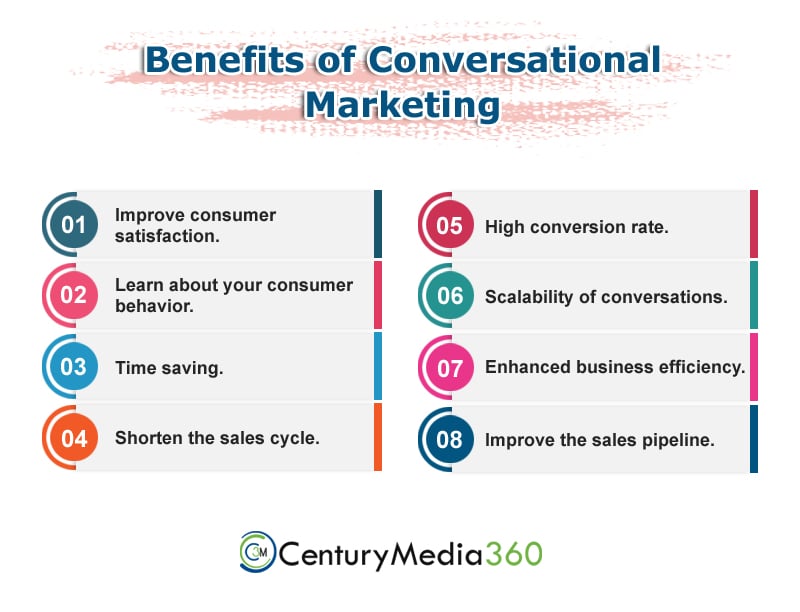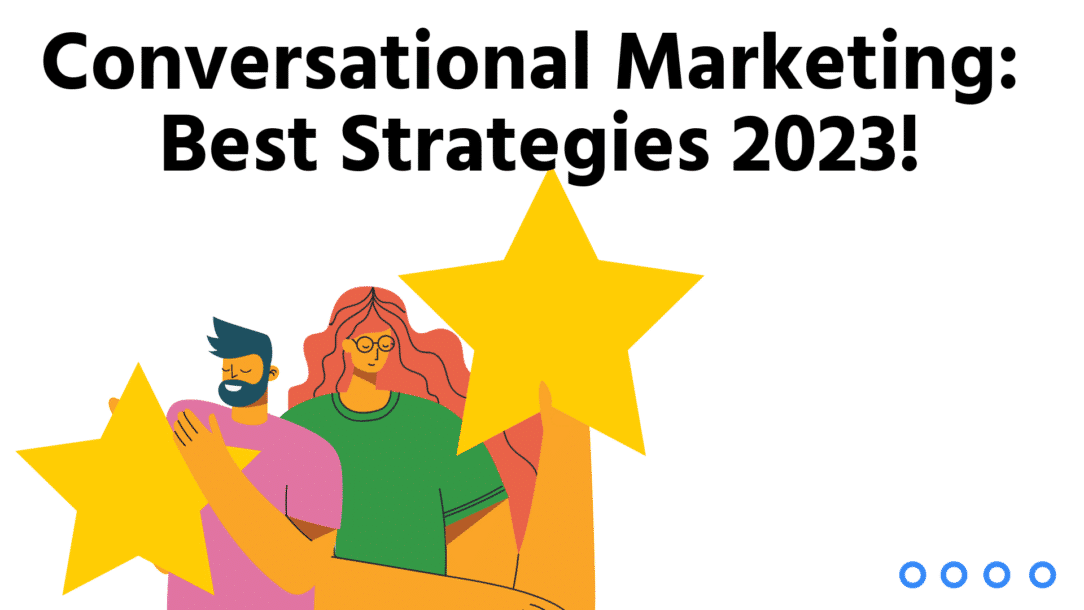2023 is the year of conversational marketing. If you think marketing is all about advertising, think again! The best kind of marketing is building relationships with your customers. This is why conversational marketing is quickly becoming the go-to way to build relationships with customers and prospects.
Conversational marketing has become a key element in digital marketing strategies, enabling companies to create an engaging and personalized customer experience. Today businesses rely heavily on conversations with customers and prospects. Facebook, Instagram, Twitter, and LinkedIn are all tools that businesses use to initiate conversations with their customers.
In this guide, we will explore what conversational marketing is and how it can help businesses increase customer engagement and conversions. We will also discuss its advantages and disadvantages, and how it can be used to build relationships between customers and businesses. We will also provide examples of successful conversational marketing campaigns and discuss the various tools and strategies available to businesses for executing effective conversations with customers.
Finally, we will provide tips on improving the customer experience and how to measure the success of conversations. By the end of this guide, you will have a comprehensive understanding of conversational marketing and how it can help enhance customer engagement and drive sales. So, let’s get started!
What is Conversational Marketing?
Conversational marketing is a new way of engaging customers and prospects that integrates traditional marketing channels with emerging technologies such as artificial intelligence, natural language processing, and chatbots. With conversational marketing, businesses can build meaningful relationships with their customers by creating two-way conversations.
When done correctly, conversational marketing can help businesses increase customer engagement and loyalty. It also enables businesses to collect feedback from customers that can be used to improve their products and services. Furthermore, businesses can use conversational marketing to provide a personalized customer experience and reduce customer service costs.
Conversational marketing includes:
- Using chatbots for customer support
- Creating conversational content that engages customers
- Incorporating AI-driven personalization
- Integrating voice search and voice recognition technologies
- Developing interactive conversational experiences using augmented reality (AR) and virtual reality (VR)
- Leveraging messaging platforms such as WhatsApp and Facebook Messenger
- Utilizing natural language processing (NLP) to understand customer intent
- Implementing AI-driven recommendation engines
- Building conversational user interfaces (UI) to create a more natural interaction
By leveraging the potential of conversational marketing, businesses can create a more personalized and engaging customer experience. They can also build stronger relationships with their customers and increase their revenue. At the same time, conversational marketing gives businesses the opportunity to collect customer data that can be used to improve their products and services. Lastly, it provides businesses with a way to quickly respond to customer inquiries, reducing customer service costs. Now that you know what conversational marketing is, let’s look at some of the key benefits of using it:
Engagement Level
One of the key benefits of conversational marketing is that it allows businesses to engage customers in real-time conversations. This helps keep customers engaged with the brand and increases customer loyalty. When customers feel that their inquiries and feedback are taken seriously, it makes them more likely to purchase products or services from the business.
Unparalleled Personalization
Another advantage of conversational marketing is that it allows businesses to provide unparalleled personalization. By leveraging AI-driven solutions, businesses can create customized experiences that are tailored to each customer’s needs and preferences. This enables businesses to provide a more engaging and relevant experience, which increases the chances of conversion.
Increased conversion rate:
You can use conversational marketing to increase your conversion rate by providing customers with the information they need in real-time. This allows businesses to quickly address customer inquiries and reduce the number of people who abandon their shopping carts. When customers are provided with timely and relevant information, they’re more likely to complete the purchasing process. The conversion rate would also increase as customers would be more confident in their decisions when provided with all the information upfront.
Normally businesses would spend a lot of time and money on traditional marketing methods such as email, direct mail, and advertising. But with conversational marketing, businesses can engage customers in real-time, thereby increasing the conversion rate.
Good return on investment rate:
Conversational marketing also offers businesses a good return on investment. As there are no printing or mailing costs, businesses can significantly reduce their marketing costs. Moreover, since conversational marketing solutions can be implemented quickly, businesses can start seeing results almost instantly. This makes it an attractive option for businesses looking to maximize their return on investment in the shortest amount of time.
Brand awareness:
Conversational marketing can also help businesses build brand awareness. By leveraging messaging platforms such as WhatsApp, Facebook Messenger, and Twitter, businesses can reach a larger audience and establish themselves as a credible source of information. Businesses can also use these platforms to create polls and surveys, get instant feedback from customers, and even host contests. All of these activities can help businesses boost their brand visibility and create a positive image in the minds of customers.
Better customer experience:
Last but not least, conversational marketing allows businesses to improve their customer service. By engaging customers in conversations and addressing their queries quickly, businesses can provide a better customer experience. This leads to higher customer satisfaction levels, which can help businesses establish a good reputation and attract more customers in the long run.
Think of it this way: by leveraging conversational marketing, businesses can provide a better customer experience, increase their conversion rate, and get a good return on investment. All of this is possible without spending a fortune on traditional marketing methods. This makes conversational marketing an attractive option for businesses looking to get the most out of their marketing efforts.
Customer feedback:
This is also a great way to get customer feedback. Businesses can use conversation marketing to collect feedback from customers in real-time. For instance, businesses can ask customers for their opinion about a product or service and then use the feedback to make improvements. Usually, traditional methods of gathering customer feedback take a lot of time and resources, but with conversational marketing, businesses can get the feedback they need in just a few minutes.
Conversations happen in customers’ time:
This is where the real magic happens. Most of the time, businesses have to wait for customers to come back with their feedback. But with conversational marketing, conversations happen in customers’ time. When customers have some queries, they can just drop in a message and get their answers almost instantly. This makes the whole process more efficient and helps businesses get the answers they need quickly.
Conversations have context:
One of the main benefits of conversational marketing is that conversations have context. Unlike emails or direct mail, which can be easily forgotten, conversations happen in real-time and provide businesses with the opportunity to build a relationship with their customers. This helps businesses understand what their customers are looking for and provide them with the right solutions. For instance, when customers mention a particular problem, businesses can instantly provide them with the right solution. Live chat solutions also allow businesses to track customer conversations in real time, which can help them better understand their customers’ needs.
Here are also some benefits enumerated in CenturyMedia360:

Conversational Marketing Benefits
Why conversational marketing is so effective?
The world of B2B and B2C marketing is rapidly changing. Customers now expect more personalization and instant gratification, which has made conversational marketing one of the most effective tools for businesses to engage customers and increase conversion rates.
Conversational marketing allows you to:
- Leverage AI-powered chatbots to provide personalized customer service
- Customer psychology principles to create persuasive conversations
- In-depth analytics to measure customer engagement and ROI
- Get to learn more about your customers, their preferences, and buying behavior
- Reach out to customers in real-time without any delay
- Meaningful conversations to build trust with customers,s which means more sales
In fact, a study shows many businesses were able to get 3% to 10% additional profits with conversational marketing compared to traditional marketing methods. This makes conversational marketing an effective tool for businesses looking to increase their profits and engage customers more meaningfully. More than 2 billion messages happen daily on Facebook Messenger, meaning if you can use a chatbot to leverage conversational marketing, you can have a real competitive advantage over your competitors.
Example of Domino’s Pizza:
Domino’s initiated the new Domino’s AnyWare, which is an excellent example of how conversational marketing can be used to engage customers. The initiative allows customers to order pizza directly from Facebook Messenger, Twitter, and channels like Slack, and Amazon Alexa. Just send pizza emojis to any of these channels, and Domino’s will deliver pizza to your doorstep. This helps customers get their orders in real-time with minimal fuss.

Domino’s Anyware
This is just one example of how conversational marketing can be used to engage customers, build relationships and increase profits. Conversational marketing is a powerful tool that can be used to create meaningful conversations and provide personalized customer service.
How Conversational Marketing is Different from Inbound Marketing:
Conversational marketing is different from inbound marketing because it focuses on creating real-time conversations with customers. Inbound marketing, on the other hand, focuses on creating content and engaging customers through various channels. Conversational marketing is about real-time customer service and building relationships with the customer, while inbound marketing is about creating content and engaging customers through various channels.
Therefore, it’s important to understand the differences between the two in order to determine which one is best suited for your business.
How Can Conversational Marketing Help Increase Customer Engagement & Conversions?
Following are some of the ways in which businesses can use conversational marketing, like chatbots to increase customer engagement and conversions:
Conversational marketing strategy and best practices
1) Determine the right mix of questions and answers:
One of the most important things to keep in mind while creating a conversation is asking the right questions and answers. Marketing teams and sales reps need to determine the right mix of questions and answers that can help create meaningful conversations with customers. The strategy would depend on the type of business, industry, and target audience. When done right, it can help increase customer engagement and conversions.
The following are the point to remember when creating questions and answers:
- Keep it concise and straightforward
- Always use customer data to personalize the conversation
- Use humor to make the conversation more interesting
- Keep the tone friendly and professional
- Offer helpful tips and advice
- Ask questions to understand the customer’s needs
- Offer helpful resources and links to relevant FAQs
2) Define your business goals and metrics that you’ll use
The second strategy when creating a conversational marketing strategy is to define your business goals and metrics that you’ll use. It’s important to identify the metrics that you’ll use to measure the success of your campaign. This will help you track and monitor your campaigns’ performance and make the necessary changes to improve it.
Some of the metrics you can use include:
- Number of leads and conversions
- Number of unique visitors and page visits
- Engagement rate
- Average time spent on page
- Number of customer inquiries
- Number of repeat customers
When you have established your goals and metrics, you can use them to improve the effectiveness of your campaigns.
3) Create a Strategy on key message points that you want to communicate
The third step in creating a successful conversational marketing strategy is to plan out the key message points you want to communicate. You need to decide what messages you want to convey to your customers and the tone of the conversation. It’s important to keep it consistent with your brand voice and message. This would help you create a positive impression on your customers and build relationships with them.
4) Determine Which Communication Channels are Best for Your Business:
The fourth step in creating a successful conversational marketing strategy is to determine which communication channels are best for your business. You need to decide which channels will most effectively engage your customers. This would depend on the type of business, industry, and target audience. Some popular conversational marketing channels include Facebook, Instagram, Twitter, WhatsApp, and other messaging apps.
It’s important to keep in mind that the conversations should be tailored for each channel. The tone and message should be consistent with the channel’s platform and audience. For instance, Facebook and Instagram are the most popular platforms for implementing Chatbot technology. These platforms have a large user base and offer businesses the opportunity to reach out to a larger audience.
5) Use previous data, past conversations, and customer history to personalize conversations:
In order to create meaningful conversations with customers, it’s important to use previous data, past conversations, and customer history. This will help marketers understand their customers better and tailor the conversation according to their specific needs. Businesses can also use data to personalize conversations and create a better customer experience. For instance, businesses can use this data to offer relevant discounts or promotions if a customer has previously purchased a product. You can also use customer reviews to personalize conversations. This helps you create a conversation with customers in an engaging, friendly, and personalized way.
6) Utilize analytics to measure customer journey:
Analytics are your best friend when it comes to understanding customer behavior and optimizing conversations. Businesses should use analytics to measure the customer journey from start to finish and identify any areas that need improvement. This can help marketers create better conversations with customers and provide personalized customer service. Let’s say you’re using a chatbotClepher, to engage with customers. You can use analytics to measure customer engagement and analyze customer patterns, such as how often they interact with the chatbot. This data can then be used to optimize the conversations and ensure you’re providing the best customer experience.
7) Use personalization:
This is true that now or then, customers would get tired of just talking in robotic tones. So, it is always a great idea to humanize the brand by using a personalized chatbot that understands customer preferences, past conversations, and personal data. It is important to use the right mix of questions and answers in order to create meaningful conversations with customers. For instance, if a chatbot is trained to use names, it is more likely to build a connection with the customers. This will help you stand out from the competition and provide an enhanced customer experience.
8) Establish Guidelines & Protocols for conversations
The fifth step in creating a successful conversational marketing strategy is establishing conversation guidelines and protocols. It’s important to set up guidelines and protocols for customer conversations to ensure that you create a positive experience for the customers. This would help you create trust with your customers and build relationships with them.
9) Test your chatbot before putting it into action
The final step in creating a successful conversational marketing strategy is to test your chatbot before putting it into action. This would help you identify any issues or bugs before your customers encounter them. You need to make sure that the chatbot is working properly and providing helpful information to your customers. This would help you improve the customer experience and build trust with them.
Once all the steps are completed, your conversational marketing strategy is now ready to launch! Make sure to monitor the performance of your campaigns and make any necessary changes to improve them. By implementing a successful conversational marketing strategy, you can build better relationships with your customers and increase the engagement of your campaigns. This would help you to maximize conversions and grow your business.
Remember, conversational marketing is an ongoing process, and it needs to be updated regularly. You need to keep track of customer conversations and make changes as needed. This would help you to provide the best customer experience and increase engagement with your brand.
Related Posts



